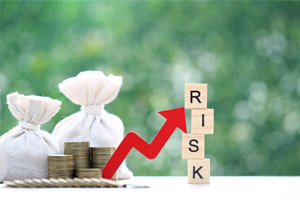If you have ever sipped on different coffee drinks, you know that they can pack varying punches of caffeine. An espresso is like a swift kick of energy. A latte is a bit milder but still gets the job done. And then there is decaf, which will not jolt you awake at all. Well, guess what? Mutual fund schemes are a bit like your morning brews. They come in different flavours of risk. Some are the espresso of investments, offering a strong potential for rewards but also have a dose of risk. Others are more like a latte, striking a balance between risk and reward. And then there are the decafs – lower-risk options that are unlikely to give you sleepless nights. This article will explore the espresso of investments - high-risk mutual funds and their features and types.
What are high-risk mutual funds?
High-risk mutual funds are characterised by a substantial level of risk. These funds are most suitable for investors with a high tolerance for risk and a long-term investment horizon. These mutual funds
invest in inherently volatile assets, like stocks. Some examples of high-risk mutual funds include active equity funds, small-cap equity funds, mid-cap equity funds, etc.
Generally, equity funds are known to inherently carry the highest risk, followed by hybrid funds and, finally, debt funds. There can be variations in risk levels within the category of equity funds, too. For example, large-cap equity funds are generally considered relatively less risky than small-cap equity funds. Nevertheless, it is essential to acknowledge that all mutual funds entail a degree of market risk.
High-risk mutual funds may offer the prospect of gains over time, but it is essential to approach them with caution.
Now that you know a bit about high-risk mutual funds, it is time to understand their advantages.
Advantages of high-risk funds
- Prospect of better growth: High-risk mutual funds offer the potential for inflation-beating growth. However, it is crucial to note that there is no guarantee of achieving them. Moreover, you should be prepared for the volatility that comes with the pursuit of these potential rewards.
- Focus on capital appreciation: High-risk mutual funds primarily target capital appreciation. They invest in assets that have the potential for significant growth, which makes them suitable for building wealth over the long term.
- Suitable for long-term goals: High-risk mutual funds are well-suited for individuals with long-term financial objectives. They can be a good choice for your long-term goals like retirement.
Taxation on high-risk funds
Profits earned from high-risk mutual funds attract capital gains tax. The tax rate differs based on the holding period of your investment. If you hold on to your investment for up to a year, you are subjected to short-term capital gains (STCG) tax. Investments held for longer than a year are subject to long-term capital gains (LTCG) tax.
STCG tax is levied at 15%, and LTCG tax is charged at 10%. However, in the case of LTCG, profits up to Rs 1 lakh per annum are exempt from any tax.
Now that you have enough information about high-risk mutual funds, you must be wondering if they are the right fit for you.
Who should invest in high-risk mutual funds?
High-risk mutual funds are best suited for well-experienced investors, as the risk may be hard to comprehend for novice investors. You should have a high tolerance for market volatility to stay invested in high-risk funds. Additionally, you may benefit from these mutual fund schemes if you have a long investment horizon, typically five years or more.
Conclusion
High-risk mutual funds are suited for experienced and risk-tolerant investors with a long-term outlook. It is crucial to have a clear understanding of the potential rewards and risks involved before making any investment decisions. It is also essential to evaluate your financial situation and aim to create a well-diversified portfolio that aligns with your needs.
An investor education initiative by Edelweiss Mutual Fund
All Mutual Fund Investors have to go through a one-time KYC process. Investors should deal only with Registered Mutual Fund (RMF). For more info on KYC, RMF and procedure to lodge/redress any complaints, visit - https://www.edelweissmf.com/kyc-norms
MUTUAL FUND INVESTMENTS ARE SUBJECT TO MARKET RISKS. READ ALL SCHEME-RELATED DOCUMENTS CAREFULLY
Trending Articles
MUTUAL FUND INVESTMENTS ARE SUBJECT TO MARKET RISKS, READ ALL SCHEME RELATED DOCUMENTS CAREFULLY.




















